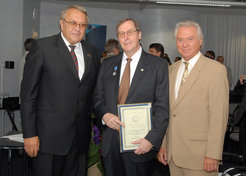Vladimir Fortov elected President of the Russian Academy of Sciences

Professor Fortov is a well-known scientist in the field of plasma and space physics, extremely high pressures and temperatures, physics and chemistry of strong shock and detonation waves, and pulsed energetics. On the basis of experimental results, he developed a general method of constructing semi-empirical equations of state (EOS) for materials in a broad range of pressure and temperature. In addition he has suggested theoretical models of thermo-dynamical, transport and optical properties of hot dense matter.
In the late 1990s, he became interested in complex plasma experiments, when he saw the first plasma crystal results from rocket experiments carried out by the group at MPE. While a normal “hot” plasma is almost fully ionized and millions of degrees hot, the “cold” plasma used for these experiments contains only a fraction of charged particles, with neutral gas and excited atoms dominating. Adding micro-particles – which can be visualised easily with a CCD camera – to this plasma has a remarkable effect: these micro-particles acquire a large electric charge and can interact strongly with one another. This means that some of the basic physical processes that Fortov had studied in dense, highly coupled plasma could now be investigated using complex plasma on the individual particle level.

In 2007, Prof. Gregor Morfill (centre) received the Ziolkowsky Medal of the Russian space agency represented by Prof. Vladimir Fortov (left). On the right, Dr. Ludwig Baumgarten (rechts), head of the German space agency DLR.
Excited by this possibility, he pushed for a joint German-Russian plasma crystal experiment on the MIR space station. Time was running too short for this idea to be realised, but in 2001, the PK-3 (later renamed PKE-Nefedov) experiment became the first natural science project on board the ISS instead. Together with its successor PK-3 Plus there have been more than 30 campaigns over the past 12 years and the next generation experiments PK-4 and PlasmaLab are already under development.
While the MPE group works with high-frequency electrical discharges to produce the plasma, Fortov’s group at the Joint Institute for High Temperatures of the Russian Academy of Sciences (JIHT) worked on a DC discharge technology. In a further joint venture between MPE and JIHT, the upcoming PK-4 experiment, which is scheduled for operations on the ISS in late 2014, will include this DC-discharge method to study anisotropic and/or multi-scale effects.
On the initiative of Fortov, a new centre for plasma research in Moscow was formed and officially opened in spring 2012. Professor Morfill is the director of this new centre and MPE scientists contribute by teaching and conducting research there. This “Research and Educational Centre for Plasma Science and Technology”, hosted at the Bauman Moscow State Technical University (BMSTU), investigates different types of plasmas and plasma technologies, including complex (dusty) plasmas, medical plasmas, modern nano-composite coatings, plasma diagnostics, and plasma sources.
Vladimir Fortov was born in Moscow, Russia on 23 January 1946. In 1962 he entered the Moscow Institute of Physics and Technology and completed his PhD in 1976 on the topic of “Physics of Strongly Coupled Plasma Generated by Intense Shock Waves”. In 1978 he received the professor’s degree in Physics and Chemistry. Since then he headed a number of divisions and institutes of the Russian Academy of Sciences, in particular, he is leading director of the Joint Institute for High Temperature (JIHT) of RAS since 2007. From 1996 to 1998, Fortov acted as Minister of Sciences and Technologies as well as Vice-President of the Russian Government. His scientific and academic achievements have been recognised by many honours and distinctions, such as the Max Planck Award for Physics, the Alfven Prize of the European Physical Society, the Distinguished Cross from Germany or the UNESCO Albert Einstein Gold Medal, to name but a few. His election to become the next President of the Russian Academy of Sciences is another great honour and challenge for him.

